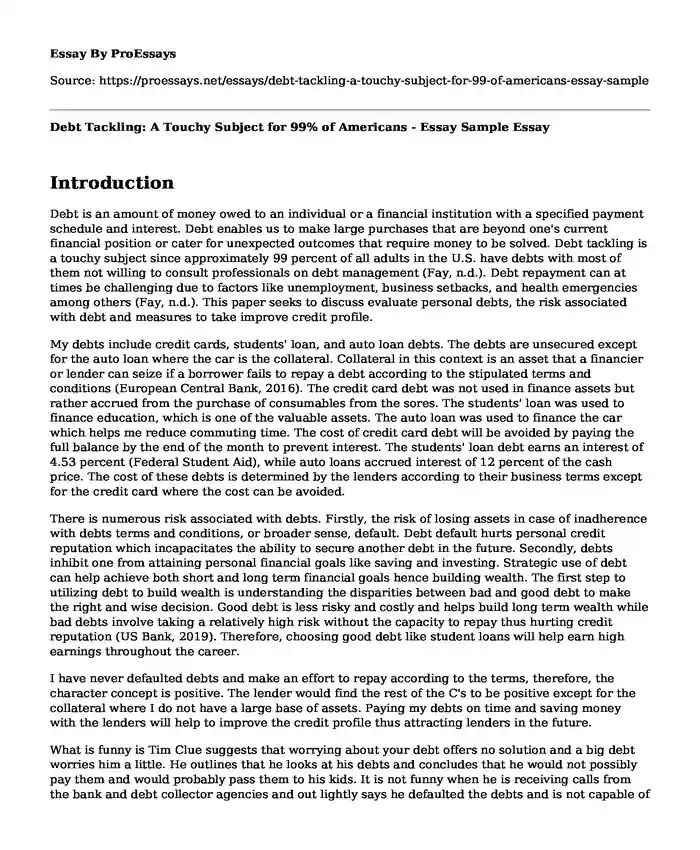Introduction
Debt is an amount of money owed to an individual or a financial institution with a specified payment schedule and interest. Debt enables us to make large purchases that are beyond one's current financial position or cater for unexpected outcomes that require money to be solved. Debt tackling is a touchy subject since approximately 99 percent of all adults in the U.S. have debts with most of them not willing to consult professionals on debt management (Fay, n.d.). Debt repayment can at times be challenging due to factors like unemployment, business setbacks, and health emergencies among others (Fay, n.d.). This paper seeks to discuss evaluate personal debts, the risk associated with debt and measures to take improve credit profile.
My debts include credit cards, students' loan, and auto loan debts. The debts are unsecured except for the auto loan where the car is the collateral. Collateral in this context is an asset that a financier or lender can seize if a borrower fails to repay a debt according to the stipulated terms and conditions (European Central Bank, 2016). The credit card debt was not used in finance assets but rather accrued from the purchase of consumables from the sores. The students' loan was used to finance education, which is one of the valuable assets. The auto loan was used to finance the car which helps me reduce commuting time. The cost of credit card debt will be avoided by paying the full balance by the end of the month to prevent interest. The students' loan debt earns an interest of 4.53 percent (Federal Student Aid), while auto loans accrued interest of 12 percent of the cash price. The cost of these debts is determined by the lenders according to their business terms except for the credit card where the cost can be avoided.
There is numerous risk associated with debts. Firstly, the risk of losing assets in case of inadherence with debts terms and conditions, or broader sense, default. Debt default hurts personal credit reputation which incapacitates the ability to secure another debt in the future. Secondly, debts inhibit one from attaining personal financial goals like saving and investing. Strategic use of debt can help achieve both short and long term financial goals hence building wealth. The first step to utilizing debt to build wealth is understanding the disparities between bad and good debt to make the right and wise decision. Good debt is less risky and costly and helps build long term wealth while bad debts involve taking a relatively high risk without the capacity to repay thus hurting credit reputation (US Bank, 2019). Therefore, choosing good debt like student loans will help earn high earnings throughout the career.
I have never defaulted debts and make an effort to repay according to the terms, therefore, the character concept is positive. The lender would find the rest of the C's to be positive except for the collateral where I do not have a large base of assets. Paying my debts on time and saving money with the lenders will help to improve the credit profile thus attracting lenders in the future.
What is funny is Tim Clue suggests that worrying about your debt offers no solution and a big debt worries him a little. He outlines that he looks at his debts and concludes that he would not possibly pay them and would probably pass them to his kids. It is not funny when he is receiving calls from the bank and debt collector agencies and out lightly says he defaulted the debts and is not capable of repaying (Kathryn, 2007).
Conclusion
In conclusion, debt is an amount of money owed to an individual or a financial institution with a specified payment schedule and interest. My debts include credit cards, students' loan, and auto loan debts. Paying my debts on time and saving money with the lenders will help to improve the credit profile
References
European Central Bank, (2016). What is Collateral? European Central Bank. https://www.ecb.europa.eu/explainers/tell-me/html/collateral.en.html
Fay, B. (n.d.). Debt Help Advice. Debt.org. https://www.debt.org/advice/
Federal Student Aid (n.d.). https://studentaid.gov/understand-aid/types/loans/interest-rates
Kathryn, L. (2007). Tim Clue on Debt. YouTube. https://www.youtube.com/watch?v=I5bbvMR8Ee4
US Bank, (2019). Good debt: Using debt to build wealth. US Bank. https://financialiq.usbank.com/index/manage-your-household/manage-debt/good-debt-using-debt-to-build-wealth.html
Cite this page
Debt Tackling: A Touchy Subject for 99% of Americans - Essay Sample. (2023, Apr 27). Retrieved from https://proessays.net/essays/debt-tackling-a-touchy-subject-for-99-of-americans-essay-sample
If you are the original author of this essay and no longer wish to have it published on the ProEssays website, please click below to request its removal:
- Essay Sample: Risk Analysis and Long-Term Investment Decisions
- Health Insurance and Managed Care Paper Example
- Research Paper on History of Riyad Bank
- Research Paper on Corporate Tax: Source of Income for Governments Since Time Immemorial
- Essay on BWIs: Key to Global Economic Growth & Prosperity
- Essay on SEC Disclosure Controls: Ensuring Data Disclosure Compliance
- Audit: Detecting Fraud & Uncovering Financial Breach - Essay Sample







